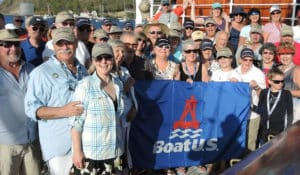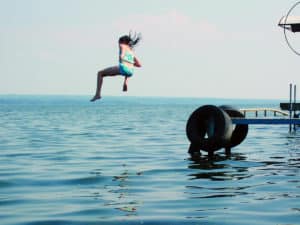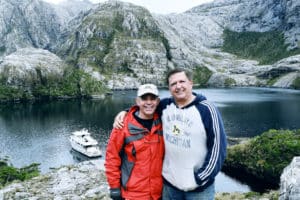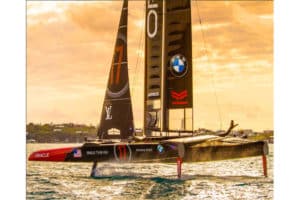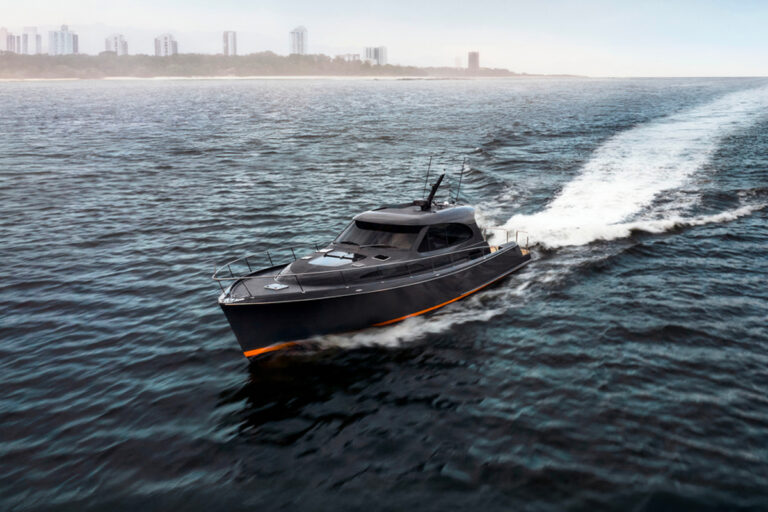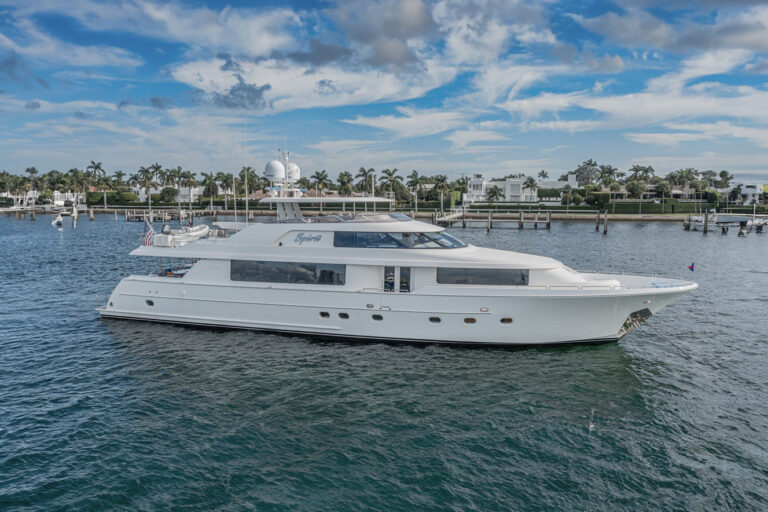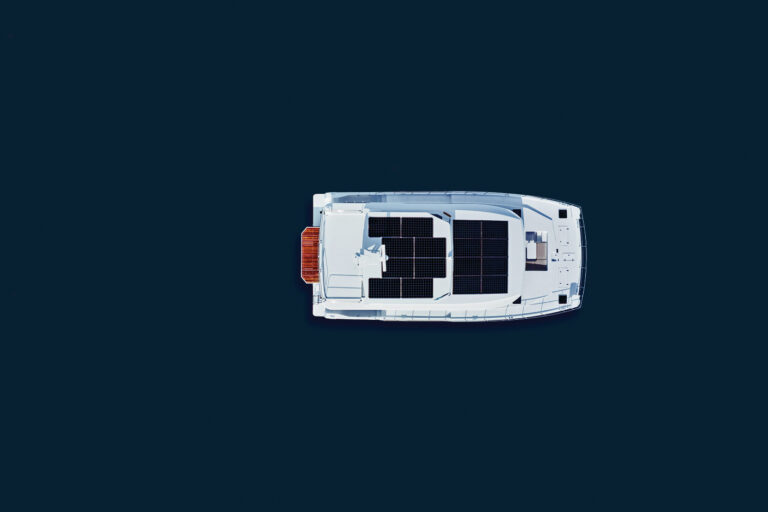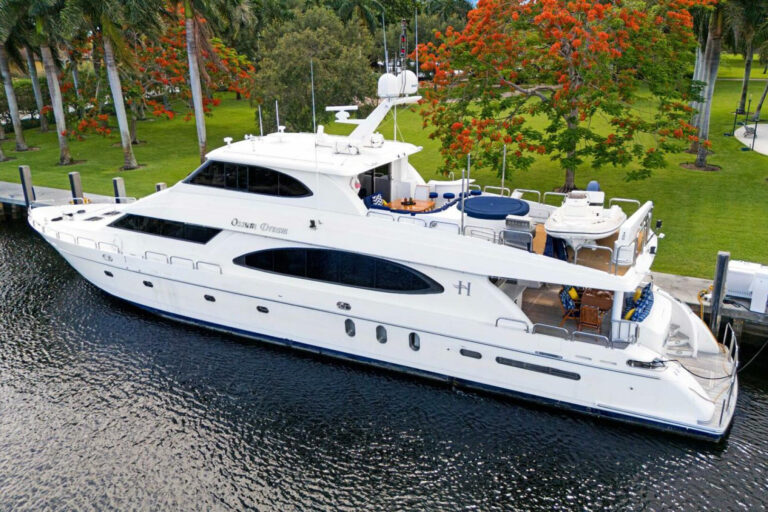Maybe it’s the cigar. Maybe it’s the name of the yacht. But nothing about Peter de Savary encourages underestimating him. Of roughly average height and sturdy build (picture a mature English footballer, one who still looks capable of delivering a respectable head-butt in a pub), Peter de Savary occupies any given space with a presence that seems larger than the sum of his physical parts. He radiates the confidence of a self-made entrepreneur, along with the sensitivity of a humanitarian.
De Savary, dressed in khaki shorts and a bright coral polo shirt-and puffing on one of his beloved Cuban cigars-appears on the afterdeck of his sailing yacht Rogue, welcomes me aboard and tells me I can have 30 minutes of his time. “What you can’t learn about me in half an hour,” he said through a smile, “you don’t want to know.”
Today de Savary wears his heart on his sleeve: his polo shirt sports the logo of The Abaco Club, his most recent project (Yachting, April 2005). Although he is here in St. Barths to race Rogue in the Bucket Regatta, his entrepreneurial nature couldn’t resist using the event as an opportunity to promote the club to this gathering of wealthy yachting society.
Although de Savary makes the bulk of his fortune developing properties, most recently a handful of golf club resorts, yachtsmen will remember him as a challenger for the America’s Cup in 1983 via the Royal Burnham Yacht Club in Essex. The syndicate christened its 12-meter yacht Victory and retained a bulldog named Winston to be the team’s mascot. Very British, indeed, but his reasons for challenging were as much personal as patriotic.
At the time, de Savary’s father was dying of cancer. During each phone call or visit to his father, who was an avid sailor, de Savary entertained him with stories about the machinations that characterize a run for the Cup. During one visit, his father advised him that if he liked the America’s Cup so much, he ought to mount a challenge. A few days later, the elder de Savary died, never knowing that his son had been involved with the challenge since 1980.
“When anyone asks about the America’s Cup,” de Savary says, “I think about my old father. I really did it [the challenge”], in a sense, to keep his spirit alive in my mind.” De Savary challenged again in 1987, but the San Diego Yacht Club refused to acknowledge his challenge, marking the end of his association with Cup racing.
Outside yachting’s circle, most people are likely to know de Savary for his unusually wide variety of enterprises. The list is long, partly because he began his adventures in business when he was still a teenager.
“I went to a private English boarding school, but only to the age of 17,” de Savary says. “Unfortunately, an indiscretion with the headmaster’s au pair caused me to leave prematurely. You could be homosexual, you could lie, you could cheat, you could steal, and you just got reprimanded. Doing something quite natural was not acceptable,” he says, dripping with irony.
Leaving school on his 17th birthday, he journeyed to Canada. There he sold paper and ink for a photocopying supply company, sold cars and the Encyclopedia Britannica. Free afternoons and evenings, he ran a little business doing landscape gardening. After three years in Canada, de Savary returned to England and went to work in his father’s furniture factory.
“I started at the bottom and worked my way up,” he says, “until I was production director and designer for the factory.” On his way up, he learned the trades of woodworking machinist and cabinetmaker.
By his middle twenties, de Savary was in West Africa, building an import/export business that dealt in bulk commodities. His parents had divorced when de Savary was still in diapers, but his mother’s eventual second marriage exposed him, via his stepfather who worked for Shell Oil, to the oil industry. He devoted about 20 years of his life to the oil business in the Middle East, Africa again, and Texas.
“Starting in the early ’80s,” de Savary says, “I developed clubs-five St. James Clubs. That sort of got me into the club business.” Today the list of de Savary properties includes The London Outpost of Bovey Castle, Carnegie Abbey on Narragansett Bay in Rhode Island, and Cherokee Plantation near Charlestown, South Carolina, a 4,000-acre estate established in 1690 as a grant from the King of England. The 61-year-old de Savary’s sensitivity for preservation and his good taste have produced timeless and desirable resorts in gorgeous and historic surroundings. His longtime fascination with gardening and landscape architecture is apparent in every one.
De Savary likens his motives to those of any artist. “At the end of the day,” de Savary says, “you have to decide what you’re working for. In my case, I’m interested in the creativity, the challenge of trying to take something that’s nothing and turn it into something of merit that perhaps will stand the test of time.”
Although his businesses are important, they don’t shape his life as much as one would think.
“So many people take business so seriously-as though it’s the overridingly important thing in one’s life,” de Savary says, “which it isn’t. All kinds of things are much more important than business-one’s family, one’s friends, one’s health.” De Savary’s wife, Lana, and their three daughters are aboard Rogue in St. Barths. They sail with him as often as time allows. “It’s not a big deal,” he says. “Nothing’s going with you. You’re going to leave it all behind.”
Recognizing the temporary nature of wealth and the possessions it buys, de Savary would like to leave behind something more meaningful. “I don’t want to leave this world having not made a conscious effort-I don’t mean just money,” he stresses. “That’s easy. Anybody can write a check. But I mean to actually use my talents in some field-God knows what-but in some field that would benefit from [those talents] when there was nothing in it for me or anyone else.” He’d also like to write a book or two.
The half hour is up, and the inner de Savary is laid bare, as promised. Now it’s on to the next project, the next castle.

